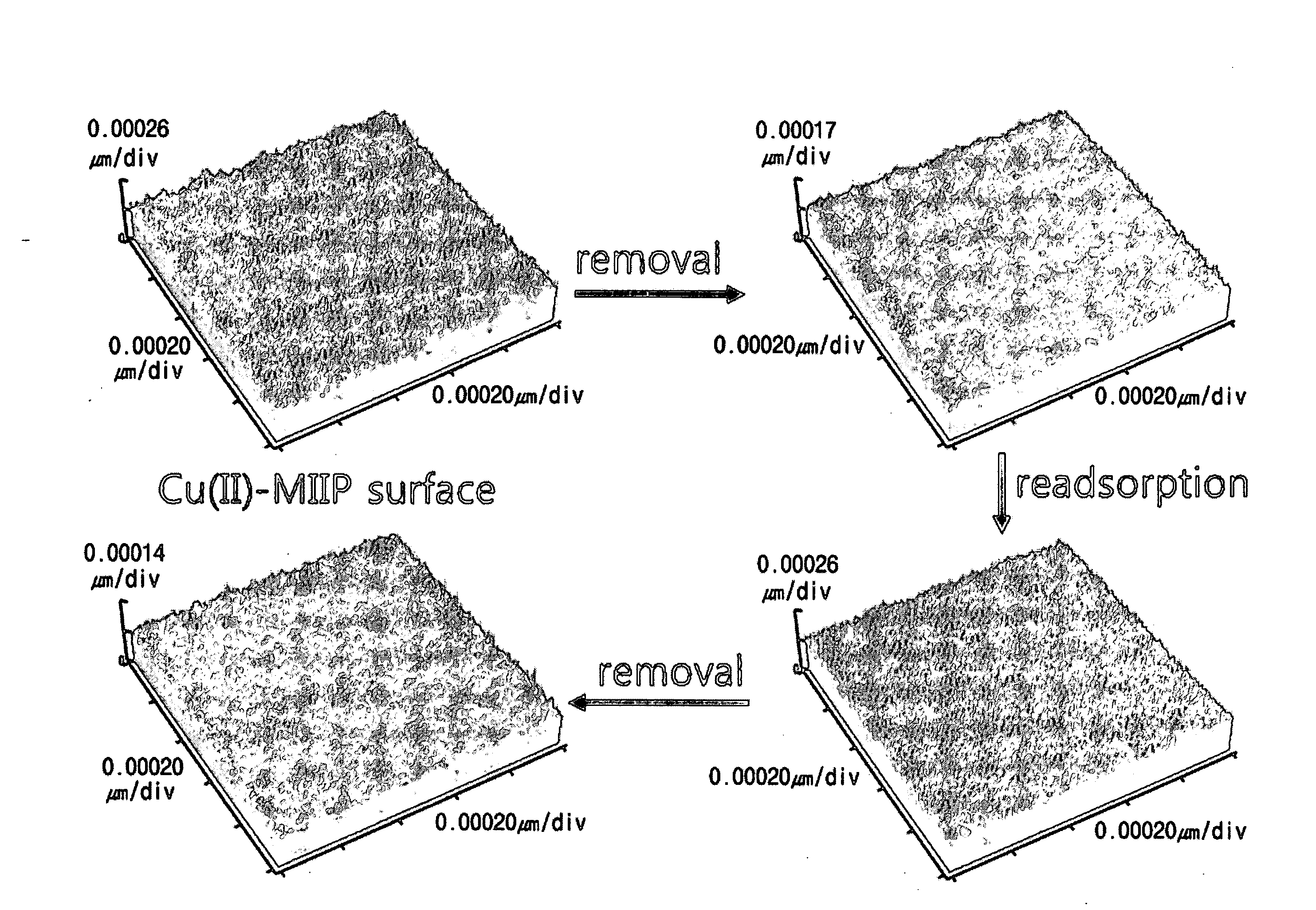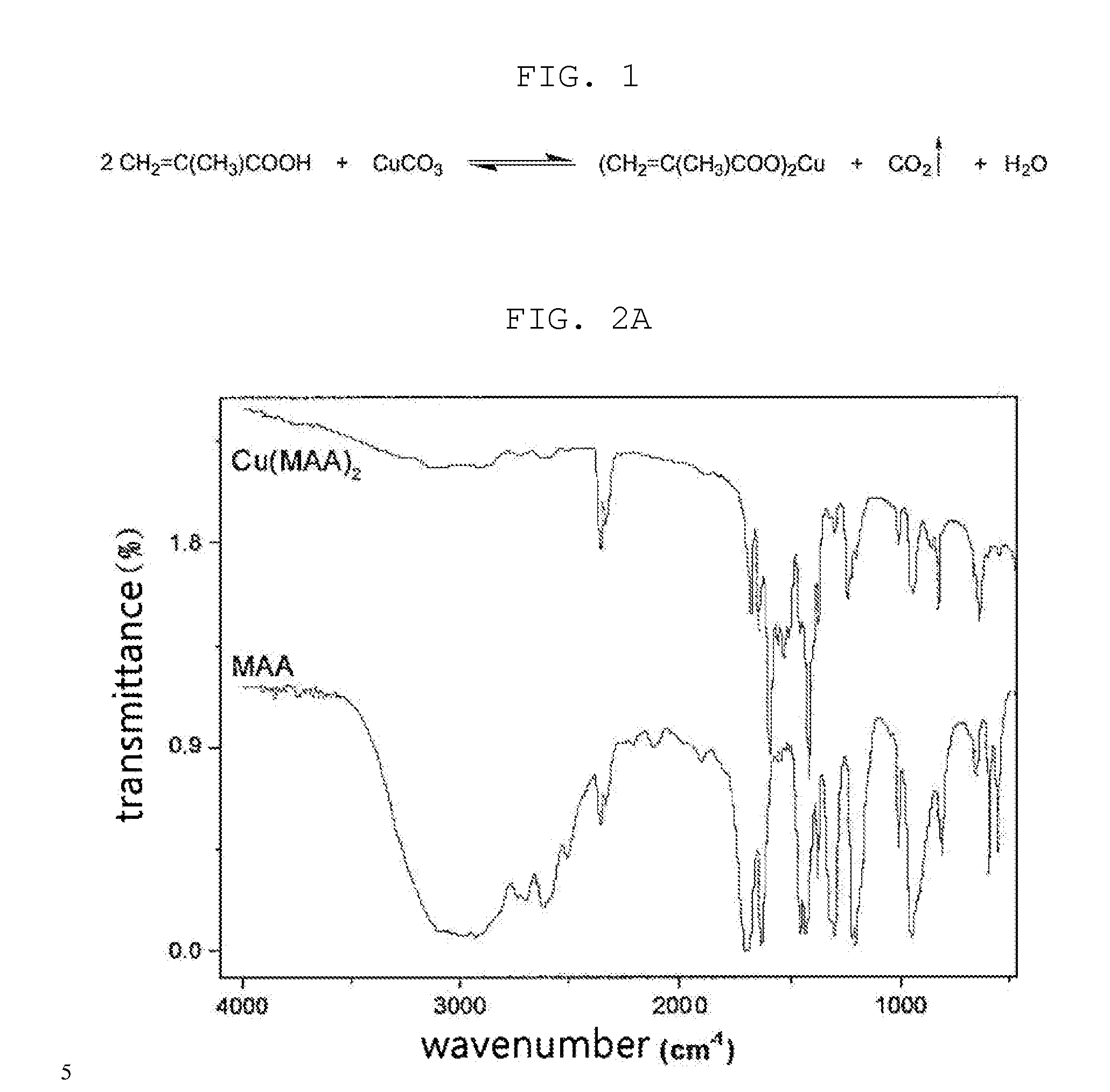Method for preparing surface-imprinted polymer microspheres in the form of core-shell for selective separation of heavy metal ions
a technology imprinted polymer microspheres, which is applied in the direction of coatings, water/sludge/sewage treatment, chemistry apparatus and processes, etc., can solve the problems of reducing the uniformity of an imprinted system, destroying the bonds between the template and the functional single molecule, and reducing the preparation yield of particles, so as to reduce the time required for the separation of heavy metal ions
- Summary
- Abstract
- Description
- Claims
- Application Information
AI Technical Summary
Benefits of technology
Problems solved by technology
Method used
Image
Examples
example 1
Preparation of Cu(II) Imprinted Polymer in Core-Shell Form
1st Step: Synthesis of Cu(II) Ion-Containing Monomer
[0053]According to the chemical reaction scheme of FIG. 1, copper carbonate (Aldrich, Milwaukee, Wis., USA) was reacted with methyl methacrylate (MAA, Aldrich), thus synthesizing Cu(II) ion-containing copper methacrylate.
[0054]To this end, copper carbonate and MAA were stoichiometrically added to dichloromethane, and were then allowed to react at room temperature for two days. The reaction mixture was filtered to thus remove undissolved impurities, after which the dichloromethane solvent was evaporated in a vacuum, thus obtaining solid copper methacrylate. Using FT-IR (IFS-66 / s, Bruker, USA), the synthesis of copper methacrylate was confirmed, and was also observed in the UV-Vis range due to the interaction between MAA and Cu(II) (FIG. 2A).
2nd Step: Preparation of Cu(II) Imprinted Polymer in Core-Shell Form
[0055]PS seed particles were prepared through dispersion polymerizati...
example 2
Preparation of Ni(II) Imprinted Polymer in Core-Shell Form
1st Step: Synthesis of Ni(II) Ion-Containing Monomer
[0060]Nickel (Ni) carbonate (Aldrich, Milwaukee, Wis., USA) was reacted with methyl methacrylate (Aldrich), thus synthesizing Ni(II) ion-containing nickel methacrylate.
[0061]To this end, nickel carbonate and MAA were stoichiometrically added to dichloromethane and were then allowed to react at room temperature for two days. The reaction mixture was filtered to thus remove undissolved impurities, after which the dichloromethane solvent was evaporated in a vacuum, thus obtaining solid nickel methacrylate. Using FT-IR (IFS-66 / s, Bruker, USA), the synthesis of nickel methacrylate was confirmed (FIG. 2C).
2nd Step: Preparation of Ni(II) Imprinted Polymer in Core-Shell Form
[0062]Imprinted polymer particles containing the Ni(II) ion, rather than Cu(II), were prepared. PS seed particles were prepared through the dispersion polymerization of styrene.
[0063]In a dispersion solvent obtai...
example 3
Preparation of Pb(II) Imprinted Polymer in Core-Shell Form
1st Step: Synthesis of Pb(II) Ion-containing Monomer
[0067]Lead (Pb) carbonate (Aldrich) was reacted with methyl methacrylate (MAA, Aldrich), thus synthesizing Pb(II) ion-containing lead methacrylate.
[0068]To this end, lead carbonate and MAA were stoichiometrically added to dichloromethane and were then allowed to react at room temperature for two days. The reaction mixture was filtered to thus remove undissolved impurities, after which the dichloromethane solvent was evaporated in a vacuum, thus obtaining solid lead methacrylate. Using FT-IR (IFS-66 / s, Bruker, USA), the synthesis of lead methacrylate was confirmed (FIG. 2C).
2nd Step: Preparation of Pb(II) Imprinted Polymer in Core-Shell Form
[0069]Pb(II) ion-containing imprinted polymer particles were prepared. PS seed particles were prepared through the dispersion polymerization of styrene.
[0070]In a dispersion solvent obtained by mixing predetermined amounts of ethyl alcohol...
PUM
| Property | Measurement | Unit |
|---|---|---|
| temperature | aaaaa | aaaaa |
| temperature | aaaaa | aaaaa |
| particle size | aaaaa | aaaaa |
Abstract
Description
Claims
Application Information
 Login to View More
Login to View More - R&D
- Intellectual Property
- Life Sciences
- Materials
- Tech Scout
- Unparalleled Data Quality
- Higher Quality Content
- 60% Fewer Hallucinations
Browse by: Latest US Patents, China's latest patents, Technical Efficacy Thesaurus, Application Domain, Technology Topic, Popular Technical Reports.
© 2025 PatSnap. All rights reserved.Legal|Privacy policy|Modern Slavery Act Transparency Statement|Sitemap|About US| Contact US: help@patsnap.com



